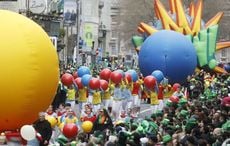Freddie Scappaticci, the former secret agent also known by his code name Stakeknife, was Britain's most valuable spy inside the IRA during 'The Troubles' it has been confirmed this week.
In a recorded telephone conversation the former commander of UK Land Forces General Sir John Wilsey, who was Army commander in Northern Ireland from 1990 to 1993, confirmed that Scappaticci — a member of the IRA's feared internal security team - was the British army's 'most important secret.'
According to the Belfast Telegraph, Wilsey said: 'He was a golden egg, something that was very important to the Army. We were terribly cagey about Fred.'
Wilsey made the admission during a telephone conversation with Ian Hurst, a military intelligence whistleblower, which was posted on the internet this week.
Hurst reportedly called Wisley's home twice last weekend claiming to be a British television researcher. In the course of their conversation, Wilsey reportedly describes two contacts he made with the agent, whom he refers to both as Stakeknife and Mister Scappaticci.
Their first meeting came during an inquiry into collusion between the security forces and loyalist paramilitaries carried out by Sir John Stevens (now Lord Stevens) the former head of the Metropolitan Police.
“The head of intelligence in Northern Ireland came to see me and said Stevens was burrowing around and that Fred Scappaticci was unsettled and would I go and see him and reassure him of the value of his work,' said Wilsey. 'That’s what I did.'
At the time Wilsey was communicating with him Scappaticci was a senior member of the IRA’s internal security section, which was tasked with uncovering police and Army informants.
At one of their meetings in south Belfast, Wilsey said he told Scappaticci that if he ever had any problems he could contact him personally. When Scappaticci had left Northern Ireland he wanted legal assistance and contacted Wilsey, who said he passed the request on to 'the proper quarters' and he believes Scappaticci was helped.
In the conversation Wilsey also revealed that Scappaticci was recruited as an agent in 1976 and that his first handler was a soldier named Peter Jones. In 1984, according to the Belfast Telegraph, a specialist agent-handling unit called the Force Research Unit (FRU) was set up and both Jones and Scappaticci were attached to it. Hurst, who released the tapes this week, also served in the FRU.
Wilsey claimed that Royal Ulster Constabulary (RUC) Special Branch 'was trying to get Scappaticci off us. They wanted him themselves. But Fred didn’t want to go with the police, because he thought they were sectarian.'
Hurst is currently preparing to give evidence at the Smithwick Tribunal in Dublin, which is examining the IRA murders of RUC Chief Superintendent Harry Breen and Superintendent Bob Buchanan at Jonesborough, Armagh in 1989. The Smithwick Inquiry was set up under Judge Peter Smithwick to investigate the murders of the two most senior policemen murdered during the Troubles. After a year of negotiations with the Ministry of Defence, Judge Smithwick secured the appearance of former Army intelligence handler Ian Hurst.
In his evidence, Hurst suggested that up to four members of the IRA gang that murdered the two senior officers could have been agents of one of other of the intelligence services active in Northern Ireland. Hurst also suggested Freddie Scappaticci was one of these agents.




Comments